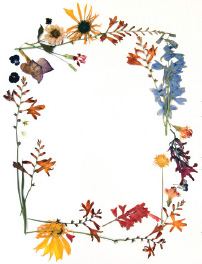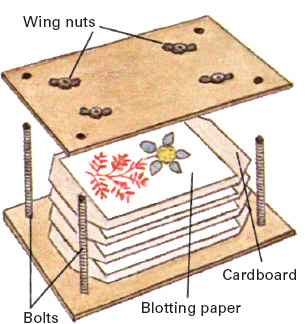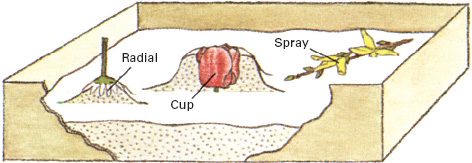Flower Drying and Pressed Flowers
Preserving the Beauty Of Summer's Blossoms

Natural beauty of flowers in full bloom can be preserved indefinitely with only a modest expenditure of time and effort.
A Homemade Flower Press
A simple, inexpensive flower press can be made from two 12-inch-square pieces of ½-inch-thick plywood, four 3-inch bolts with wing nuts, six pieces of cardboard, and 12 sheets of blotting paper. Flowers can be put in the press along with leaves and stems, but be sure to keep them on separate sheets of blotting paper. The petals of bulky flowers, such as roses and peonies, should be removed and pressed individually. If the flower has a thick center, flatten it with your thumb before putting it in the press.
Arrange compatible plant parts on a sheet of blotting paper, and cover with a second sheet. Place a piece of cardboard on top, then arrange additional layers in the same way. Put the stack between the two pieces of plywood, insert bolts, and tighten wing nuts firmly. Leave press in a warm, dry place for about four weeks.
The colorful blooms of spring and summer need not fade with the passing season; instead, they can be gathered and preserved for year-round pleasure. Almost every type of plant can be preserved—from the most delicate flower to the hardiest grain and shrub—either by pressing, air drying, or using a drying agent.
Proper harvesting is the key to rich, bright, long-lasting colors. Ideally, flowers should be gathered when the weather is dry, just before the peak of bloom. If an extended run of inclement weather forces you to cut the flowers while they are wet, blot away the moisture with absorbent tissues to prevent mold from forming.
Dried flowers lend themselves to a number of uses, including flower arrangements, pictures made of pressed flowers, and decorations on stationery, bookmarks, and greeting cards.
How to Dry Flowers
Because of differences in structure and texture, the leaves and stems of plants usually must be dried separately from the flowering parts. The three basic ways to dry plants are hanging (air drying), impregnating with a glycerine solution, and burying in a granular desiccant, or drying agent.
Hanging is the easiest method and requires no special equipment. It is most successful with flowers that have tiny clustered petals, such as baby's breath and golden-rod. Tie the stems of a small bunch together with twine, hang them with their heads down in a warm, dry, dark place for three to four weeks.
Grasses and leaves dry best when their stems are placed in a solution of one part glycerine and two parts very hot water. (If there is bark on the stem, strip it away until about 4 inches of the stem is bare.) Split the ends, and stand the plants in 4 inches of solution. Remove them when their colors start to change and all brittleness has disappeared—usually within one to three weeks.
Different methods for different plants
| Air drying | Drying agent | Pressing |
| Amaranth | Azalea | Beech leaves |
| Artemisia | Carnation | Bluebell |
| Baby's breath | Chrysanthemum | Ferns |
| Butterfly weed | Daffodil | Galax |
| Celosia | Dahlia | Ginkgo |
| Chinese lantern | Daisy | Hickory leaves |
| Cockscomb | Dogwood blossom | Liriope leaves |
| Feverfew | Geranium | Maple leaves |
| Goldenrod | Larkspur | Oak leaves |
| Heather | Lilac | Pansy |
| Hydrangea | Peony | Poppy |
| Scotch broom | Rose | Rose leaves |
| Sumac | Snapdragon | Violet |
| Yarrow | Zinnia | Vitex leaves |

A simple press is all that is needed to preserve flowers for decorative purposes.
For such large, delicately petaled flowers as roses, carnations, and peonies, granular desiccants produce the best results. Three standard desiccants are perlite, silica gel, and borax mixed with cornmeal or sand. Spread an inch or two of the desiccant on the bottom of a box and lay the flowers on it. Then cover the flowers thoroughly with more desiccant, making sure to fill spaces between petals. The treatment takes two to four days.

Position flowers according to shape when using desiccants—faceup for cups, facedown for radial shapes, flat for sprays.